Let’s talk about butts.
Sorry, you know I had to do that. It was too easy!
OK, let’s talk about handgun butts, and specifically, the difference between square butt and round butt grip frames.
S&W Time Machine
The revolver giant we know as Smith & Wesson got its start in the mid-Nineteenth Century, when the two partners joined forces to create a lever action, “Magazine Pistol” (the Volcanic) that was first manufactured in 1853.1
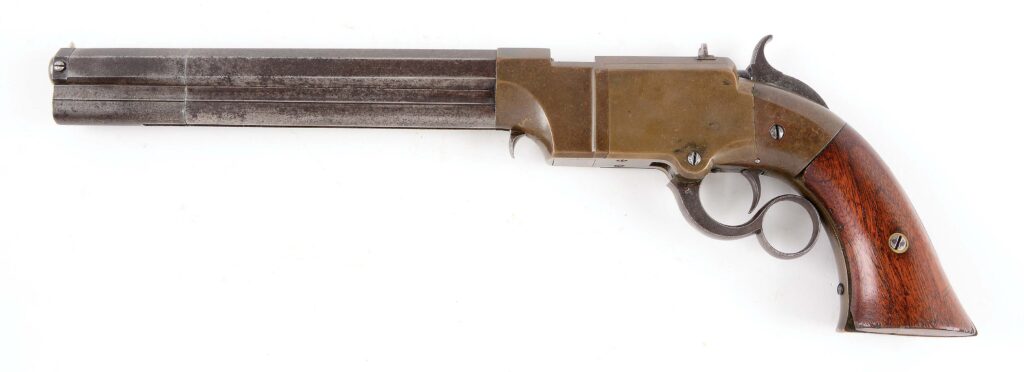
Shortly thereafter, in 1857, they began manufacturing a series of tip-up revolvers that featured square butts like the Volcanic, at first, but soon changed to grip frames with a rounded profile at the bottom, rear of the grip (or “butt”). The round butt profile was retained for the .32 and .38 caliber top-break revolvers that followed, in the 1870s and 1880s, and was also used on the .44 caliber Model 3 Russians and New Model Number Threes, beginning in 1873.2
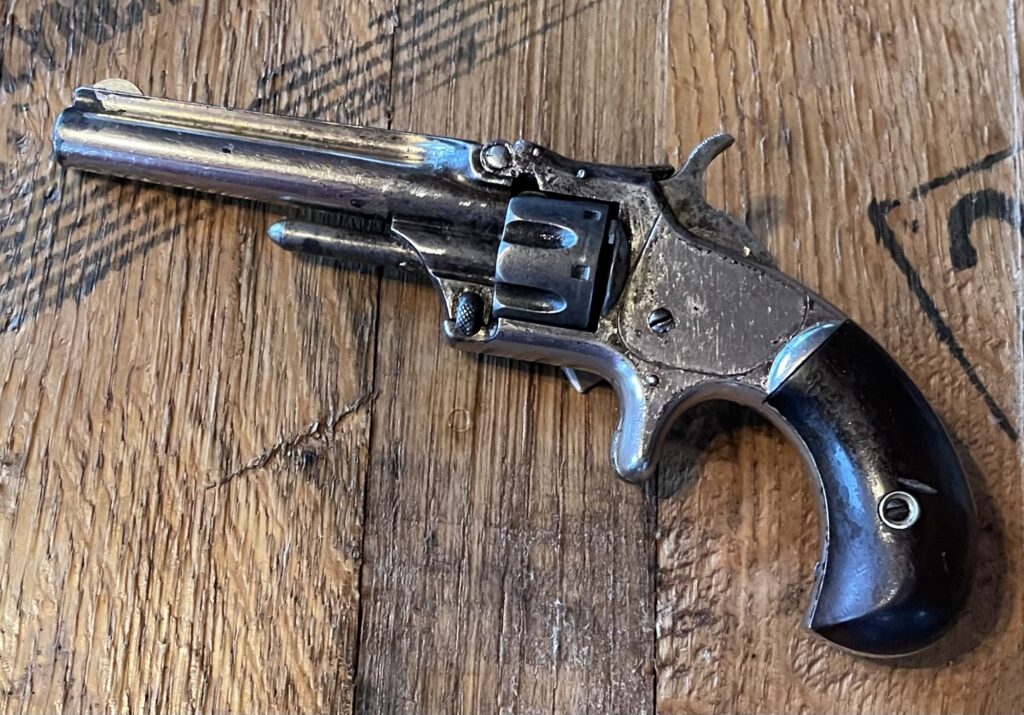
The grip frames on these diminutive revolvers were quite small, offering the shooter just enough space to wrap a finger or two around the hard rubber or wood stocks that were secured to the abbreviated frame. Since the butt of the revolver was so short, it didn’t extend past the bottom of the closed hand that held it. Instead, the bottom, rear of the frame would bear against the palm when the gun was gripped, which made a smooth, rounded butt profile a very good choice for control and comfort.
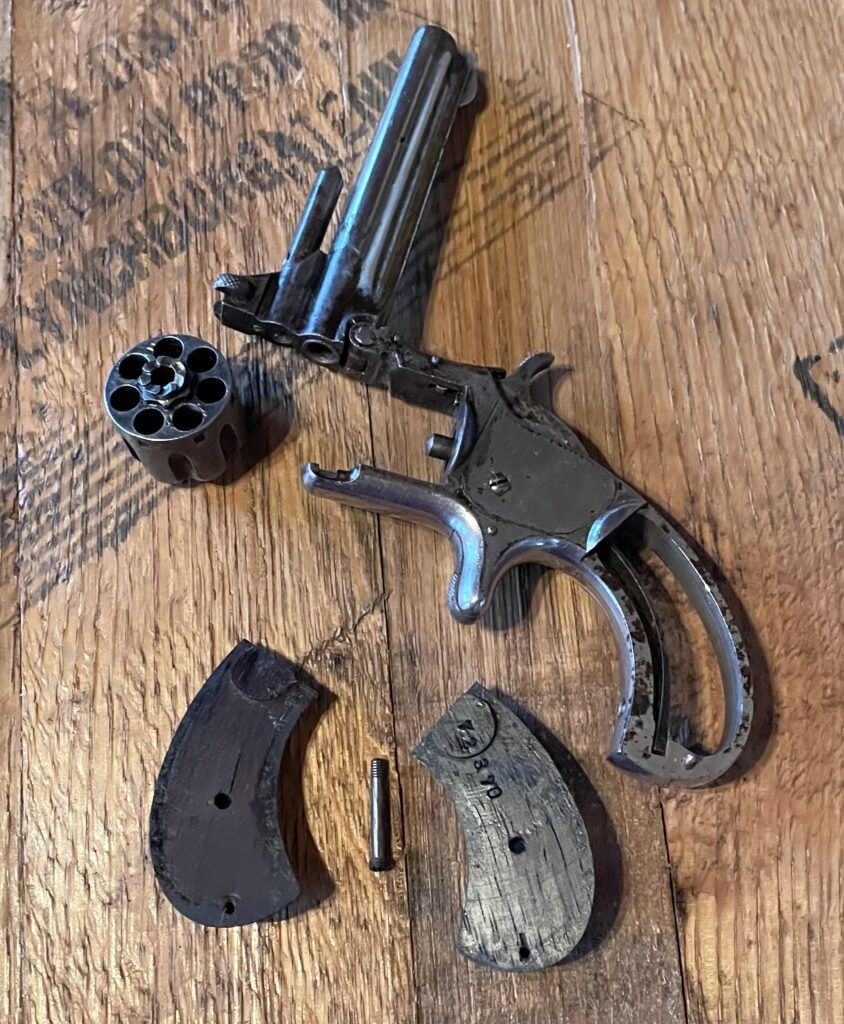
When the first K-Frame, Model of 1899 Army-Navy (later to become the famous Military & Police revolver, or Model 10, as it was designated in the switch to model numbers in 1957) made its debut, its butt sported a rounded profile like the top-break and single-shot S&W revolvers that came before it. However, by 1904, a so-called, “square butt” was introduced on the current version of the .38 Military & Police revolver (the Model of 1902, First Change), in which the fore and aft corners at the bottom of the grip frame flared outwards a bit, terminating in angled points, instead of radiused curves.3
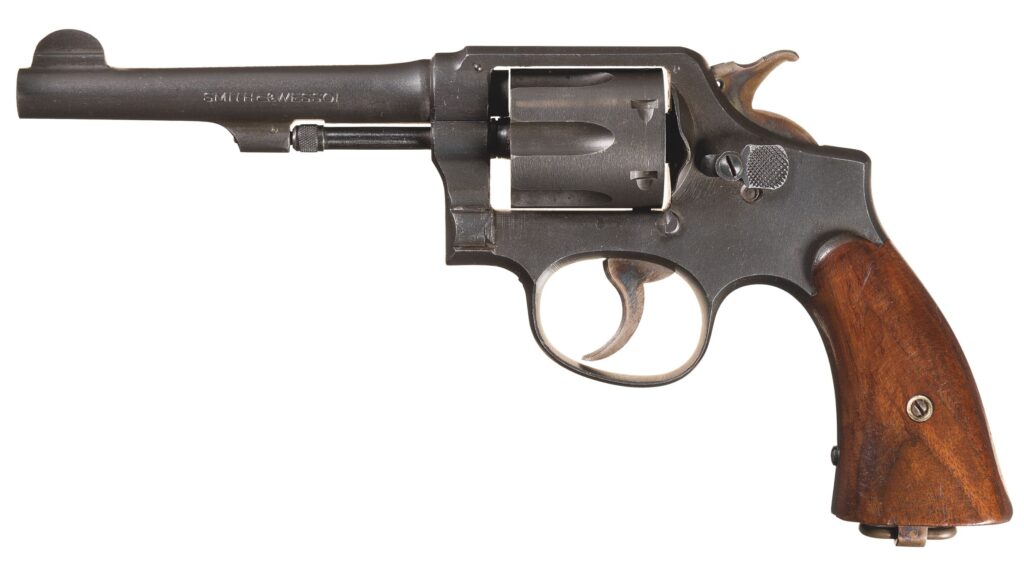
The square butt (SB) profile introduced on those K-Frames proved to be popular, so when the large, N-Frame revolvers were introduced in 1907, they, too, were all configured with square butts. So were the hundreds of thousands of .38/200 British Service Revolvers and .38 Special Victory Models that S&W cranked out for the war effort. In fact, by World War II, the square butt profile dominated the Smith & Wesson line, and you could only find a round butt (RB) on a few K-Frames and on the small I-Frames.4
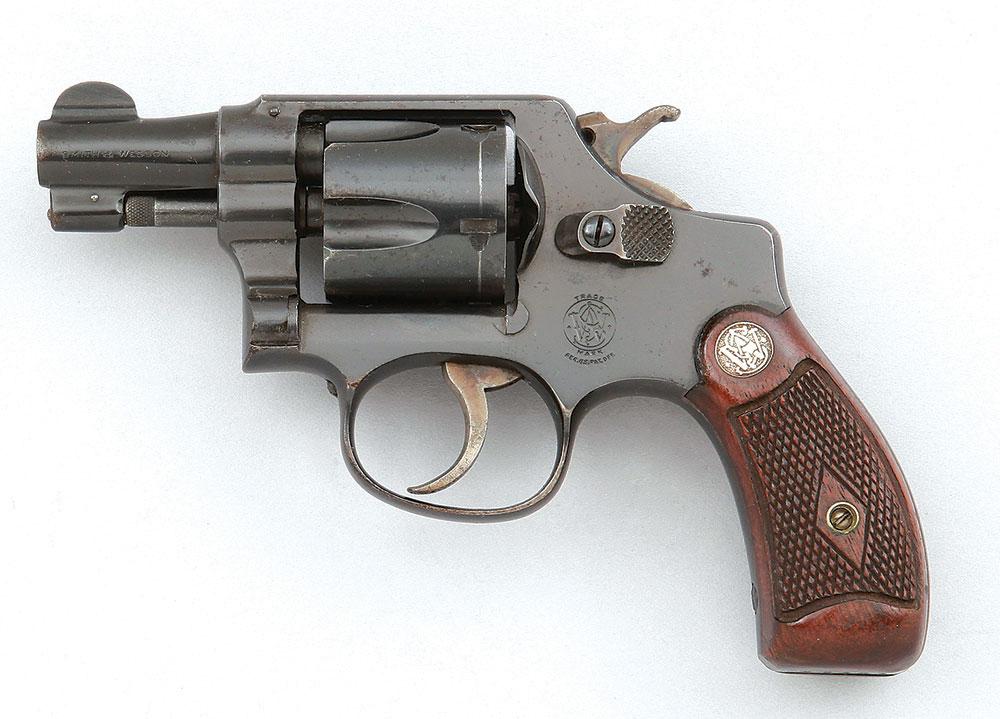
This continued after WWII, as well. Smith & Wesson offered some RB models in the post-war years, but they were far outnumbered by the supply of SB models. Generally, the RB was only found on small, compact revolvers (like the I-Frames, or the new, larger J-Frames, which were introduced in 1950), or medium-frame revolvers with abbreviated barrel lengths, that were meant to be carried concealed (the snubby K’s). Any guns intended for service use, outdoorsmen, or target shooters were generally equipped with the SB profile.
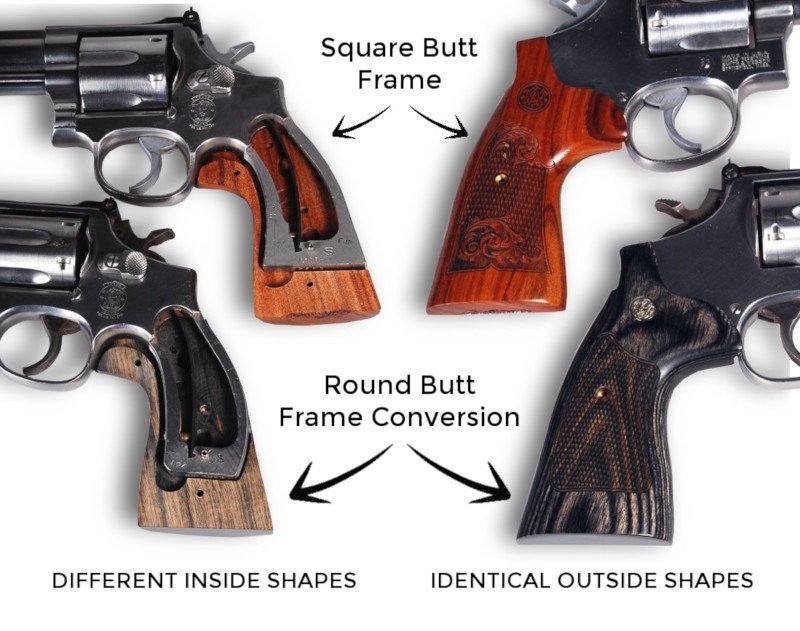
This state of affairs lasted up until 1995, when Smith & Wesson decided to discontinue the SB and manufacture all their revolvers with RB frames. The move was designed to promote manufacturing efficiency, and since it was possible to make a round butt frame feel like a square butt with properly-configured stocks, S&W didn’t believe their customers would miss the square butt frames.
Pony Butts
Smith & Wesson wasn’t the only manufacturer to offer both square and round butt profiles on their revolvers.

The earliest Colt double-action revolvers, the Model 1877 Lightning (chambered in .38 Colt) and Thunderer (chambered in .41 Colt), had “bird’s head”-style grips that featured a prominently-rounded profile on the butt of the gun, but by the time the Navy (1889) and New Army and Navy (1892) Models were developed, the grip frame had gone back to a square profile that was more reminiscent of the Single Action Army.5
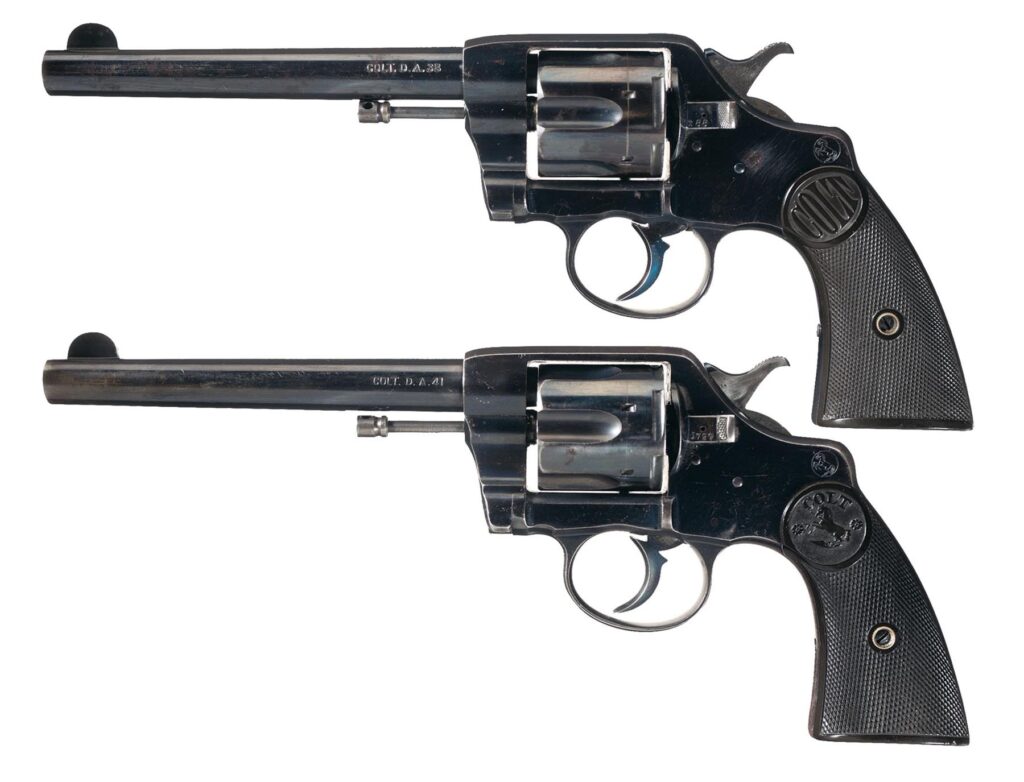
The square butt, Army and Navy grip frame would be used on all of Colt’s 20th Century service guns (minus the rare Marshal) and is still, amazingly, in use on today’s 2020-update of the classic Python.
The first small frame, swing-out cylinder, double-action revolver from Colt was introduced in 1893, as the New Pocket. It featured a round butt profile, which remained as this model morphed into the Pocket Positive, Police Positive, Police Positive Special, and Detective Special.6
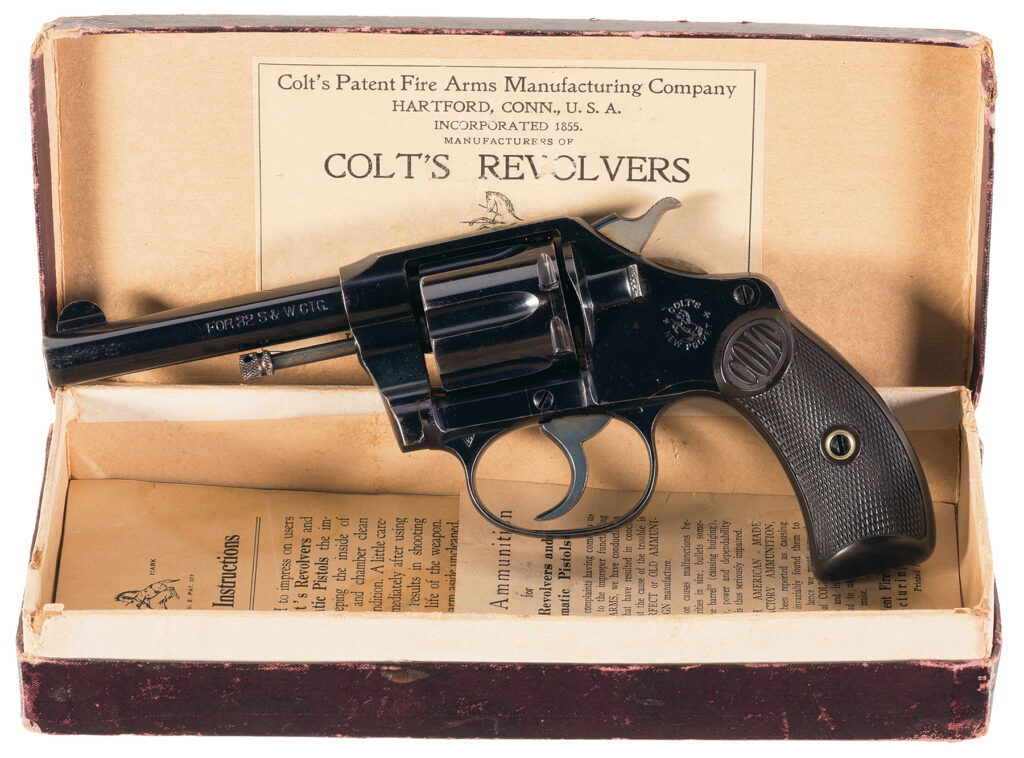
So, as with Smith & Wesson, Colt eventually adopted a pattern in which almost all of the service-sized guns wore square butts (including some of the small frame—i.e., Police Positive—revolvers with four-inch or longer barrels), and the snubby, pocket-sized revolvers were generally equipped with round butts.
Eagle Butts
Young upstart, Sturm-Ruger, also played the square and round butt game.
The medium-frame Security Six revolver was introduced in 1970, and had a square butt from the start. So did the fixed-sight, Service Six version of the gun, which was born shortly thereafter.7
In contrast, the fixed-sight Speed Six, introduced in 1973, had a round butt, to satisfy those shooters who preferred the format.8
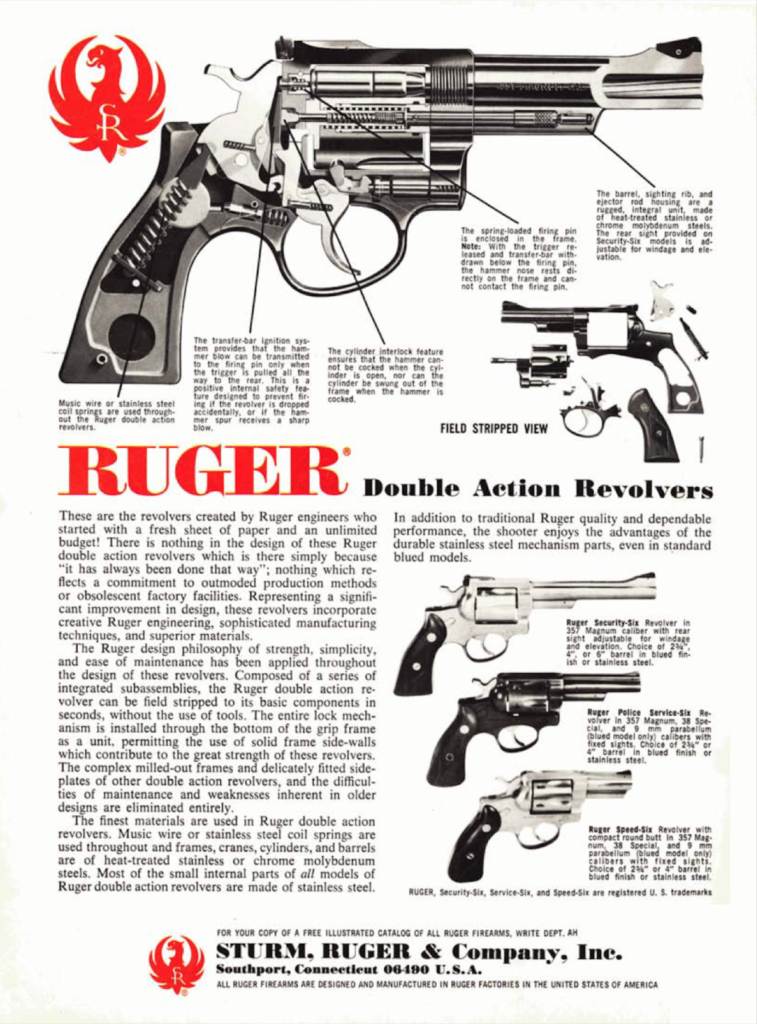
Interestingly, the choice of round or square butt wasn’t clearly linked to barrel length at Ruger, like it was at Smith & Wesson. The square butt, Security Six was offered with a shortened 2.75” barrel, for example, in the same fashion that the round butt, Speed Six was offered with a service-length, 4” barrel.
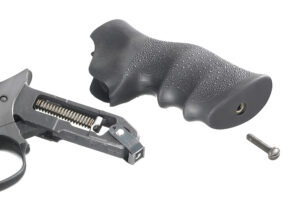
In any event, the advent of the GP100 (1985) and SP101 (1988) revolvers, with their “peg”-style grip frames, ended the RB and SB era at Ruger. More than a decade before S&W reached the same conclusion, Ruger had figured out that a single frame style could be readily converted to RB or SB profile at will, with just a change in grips, and it would simplify production to only make one style of frame.9
Round Butt Advantages
So, what are the perceived advantages of the round butt grip frame?
We’ve previously discussed how the early S&W revolvers had short butts which didn’t extend beyond the bottom of the hand when they were gripped, so the bottom, rear of the frame pushed straight back into the palm. On a gun like this, a rounded butt profile is much more comfortable than a square butt grip which terminates in a sharper point, and concentrates the force of recoil in a small area. This is a big reason why you see small guns, like the S&W J-Frames, being made with round butts, today.
The round butt also seems to be a little more forgiving when you’re trying to acquire a fast grip on the gun, as you would during an emergency draw. If you miss the desired spot on the backstrap, and grasp your square butt revolver too low, your hand can really struggle to achieve a decent firing grip on the gun, and if your hand is relatively small, you may not even be able to reach the trigger, since the square butt’s flare draws your hand further away from the trigger as your hand slides down the grip. I’ve also experienced the opposite phenomena, where the flared profile of the square butt can guide your hand into a position that’s a little too high on the backstrap, during a hurried draw. In contrast, a sloppy grip on a round butt usually seems to work out better, especially for those with smaller hands.

For that matter, small-handed shooters may benefit from the round butt’s slightly-reduced trigger reach, even if they grip the revolver correctly.
Additionally, shooters who carry their guns inside the waistband benefit from having the bottom, forward corner of the frame trimmed and rounded, as it makes it easier for the fingers to slide into position on the gun, in the narrow gap between the front strap and the top edge of the belt (or the top edge of the holster). The round butt frame just makes it easier to get a good grasp on a gun carried in this position.
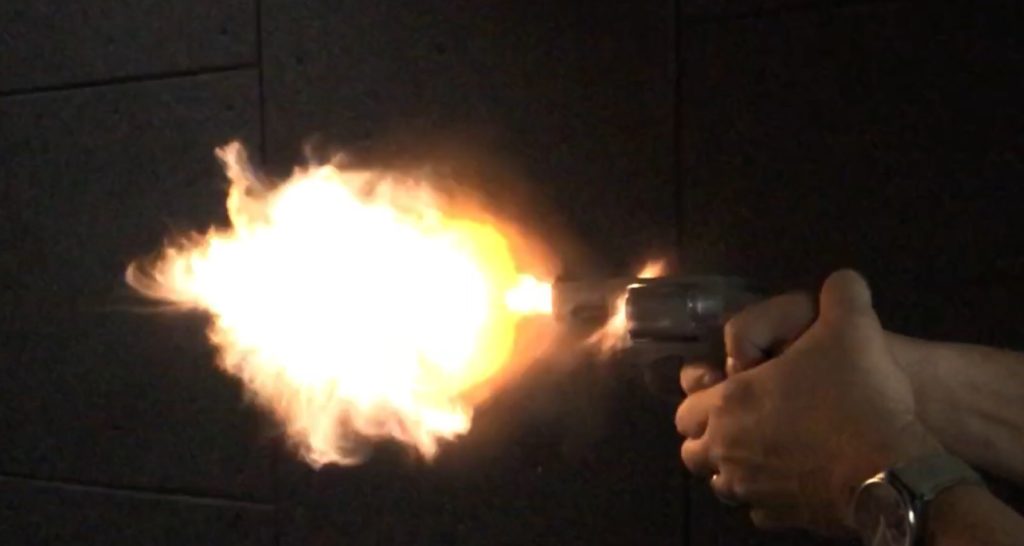
A round butt grip also seems to work a little better for rapid, double action firing than a square butt grip. The round butt seems to “roll” in the hand a little more naturally, and the lack of a flare at the bottom of the grip may also help to keep the shooter from “heeling” the gun, or shifting the muzzle upwards by applying too much force on the bottom, rear of the grip as the hand clenches along with the moving trigger finger, during the trigger press.
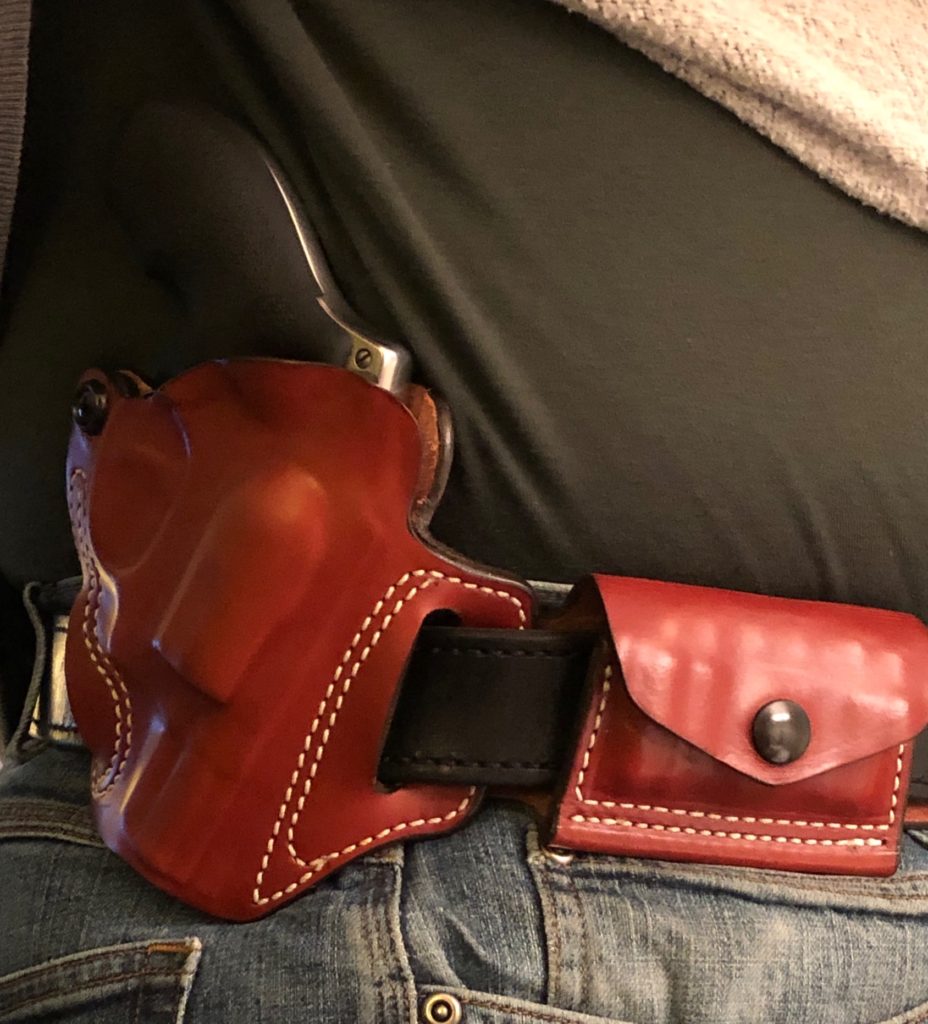
Perhaps the most significant advantage of the round butt, however, is that it helps to reduce printing when the gun is carried concealed. The pointed profile of the square butt’s bottom, rear corner can be difficult to hide, particularly under light garments. It’s this problem which helps to explain the continued popularity of forward cant/rearward rake (“FBI Cant”), strong side holsters for concealed carry, and the choice of round butts to help mitigate the issue.
The round butt can also be easier to present from a pocket, as the square butts tend to hook on pocket lips, and foul the draw. Fitz knew all about this, which is why his signature conversions always incorporated a rounded butt as part of the package.
Square Butt Advantages
What of the square butt, then? Why would a shooter choose a square butt if the round butt offers all of those advantages?
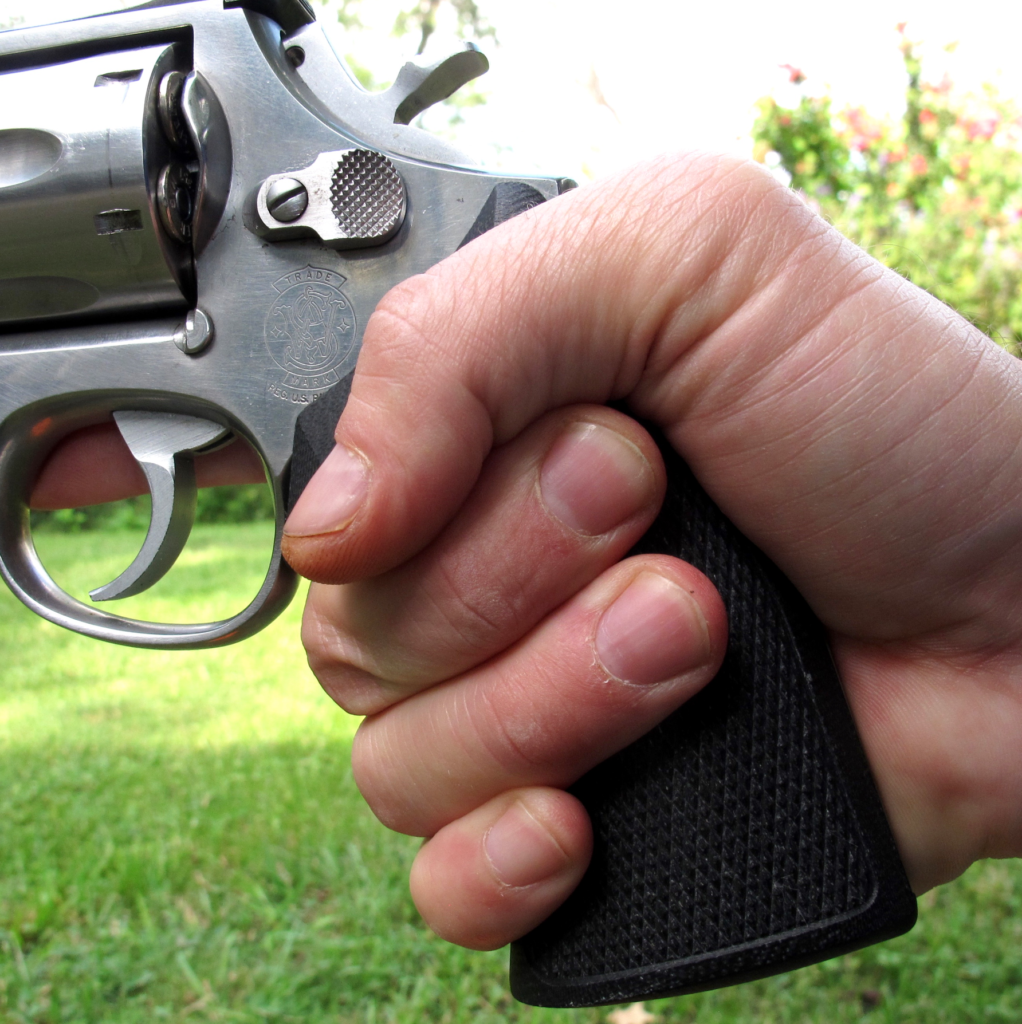
The larger profile of the square butt works well for many shooters with average-to-large hands, who feel they gain better control of the revolver with the added gripping surface. The flare at the front of a SB grip plays an important part in this, by giving the pinky of the closed firing hand a surface to bear on, during recoil. With a RB profile, the pinky often doesn’t have much to get a purchase on, and can’t contribute as much to fighting muzzle rise.
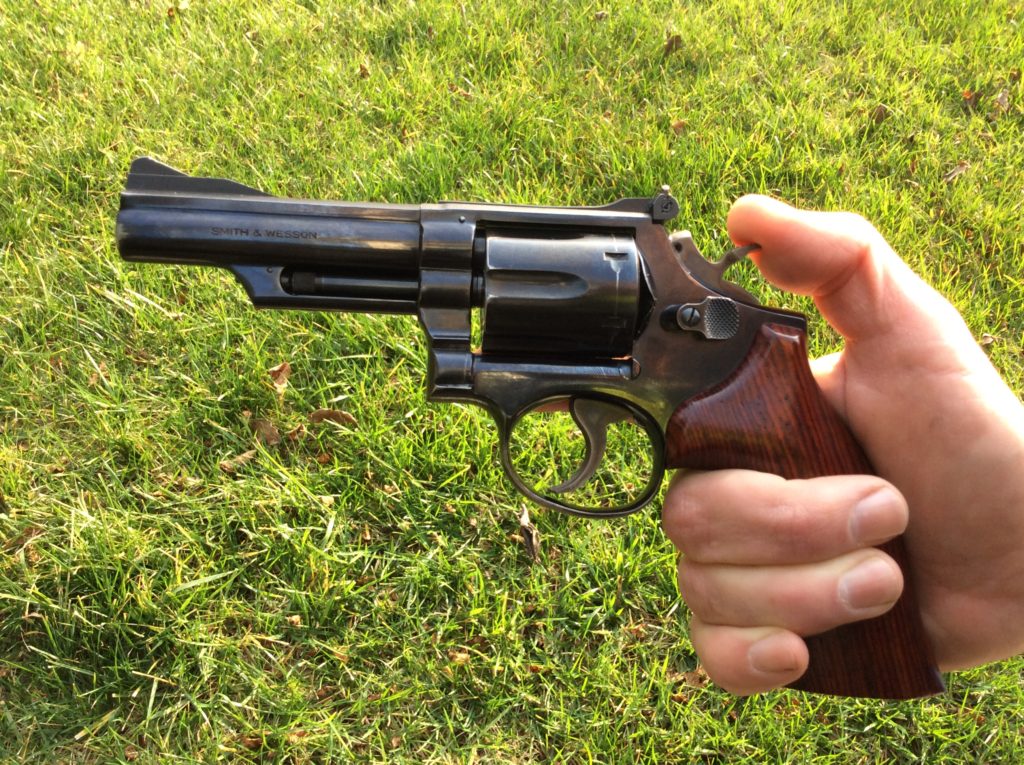
The larger, flared profile of the square butt can also be an aid during single-action fire. As generations of SAA shooters can attest, a frame with a flared bottom and a thinner neck positions the hammer spur close to the thumb after the gun recoils, setting things up nicely for the shooter to cock the hammer again.
It’s also seems that the square butt profile allows the shooter to exercise better single-action trigger control, particularly on revolvers with long barrels. These long barrels make the gun muzzle heavy, and, with the top of the middle finger serving as a fulcrum, the gun is encouraged to rotate forward. The flare at the bottom, rear of a square butt grip allows the heel of the hand to counteract this force, by bearing on the frame in a way that cams the muzzle back up. By allowing the heel of the hand to do all the work, just by its natural position, the fingers of the shooting hand don’t have to grip the gun as hard to control it. This overall relaxation of the grip allows the trigger finger to be more relaxed and do better work on the short, light, single-action trigger.
That flare at the bottom of a square butt can also help to pop the muzzle of a gun out of a spring-loaded, break front holster, when the heel of the hand comes down onto the grip during a draw, and it also helps to get a long barrel rotated and raised onto the target quickly during a draw—facts which were definitely appreciated by law enforcement officers in the era when the six-inch service gun was King, and duty holsters weren’t made of plastic.
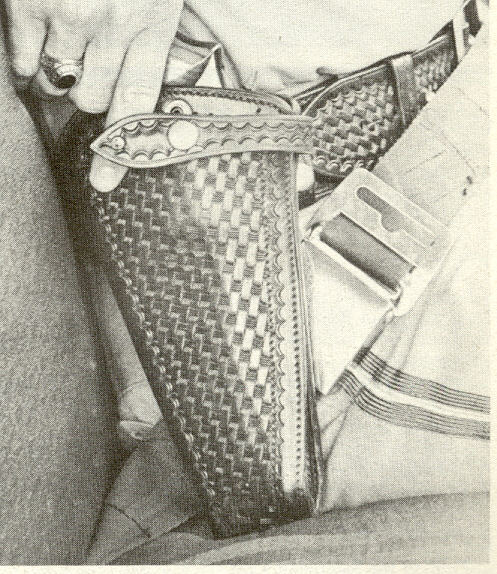
Of course, a duty revolver that’s openly carried (as in military service or uniformed patrol) doesn’t need to be concerned with printing—if an angled corner sticks out a little more when the gun is carried in a flapped military holster or a basketweaved Jordan, so what?
Tools For The Job
Understanding these relative strengths, it makes sense that we’re much more likely to see a square butt profile on a long-barreled, target or hunting revolver, particularly since the shooters in these pursuits often favor single-action fire, as an aid to achieving accuracy.
For similar reasons, it’s also no surprise that the square butt was popular on duty (military and police) guns in an era when they typically wore five-inch or longer barrels, and the manual of arms prioritized single-action fire, leaving double action fire for only the gravest extremes.
When service gun barrel lengths trended towards three to four inches, and double-action fire replaced single-action fire as the desired method of operation for defensive shooting, we saw round butts make some inroads on duty gear. Of course, they had always been popular on the medium and small-frame guns that were designed to be carried concealed, and quickly drawn from hiding.
Round or square butt? It’s a matter of preference, and of matching the tool to the job.
Conversions
In the era when Smith & Wesson (and, to a lesser degree, Colt) closely tied frame styles to barrel lengths, it was hard to get a four-inch service gun, or a six-inch hunting gun, with a round butt. If you wanted one, you had to take the same route as the guy who wanted to turn his four-inch, square butt gun into a two or three-inch gun, optimized for concealment—custom gunsmithing!
RevolverGuy regulars might recall Steve Tracy’s Fitz’d Colt 1917, and how the square butt of that fine service gun was expertly rounded by the unknown gunsmith who also bobbed the hammer, cut down the barrel, and removed the front of the trigger guard. That was an example of how to do the job right.
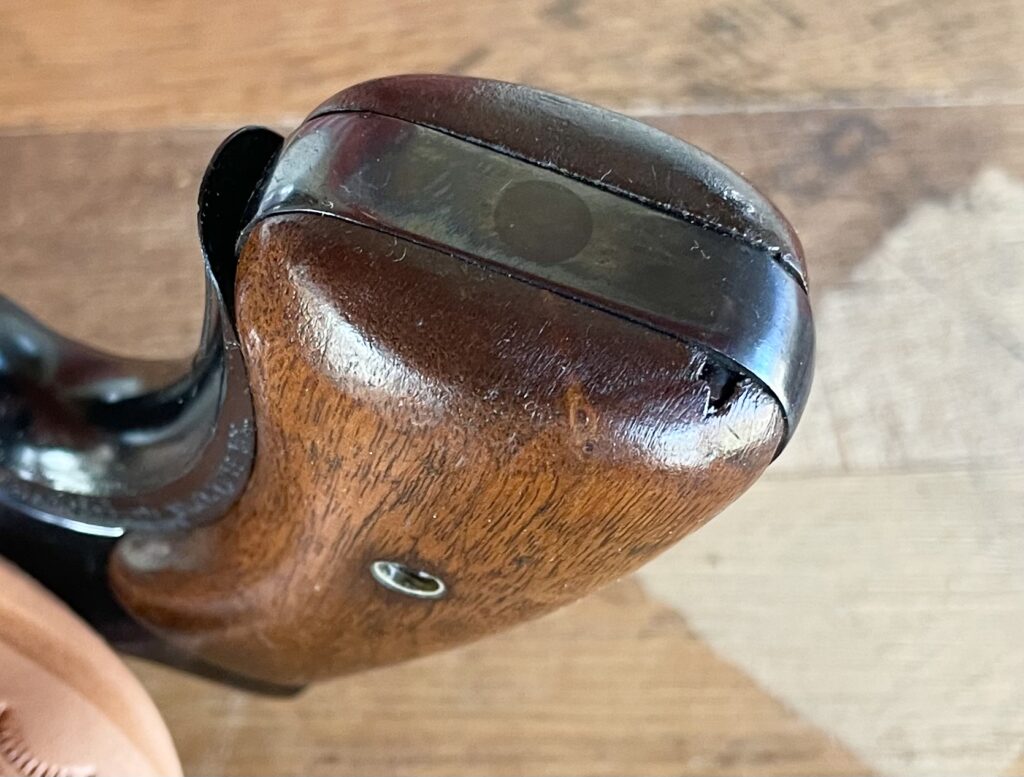
Yet, while square butt-to-round butt conversions aren’t difficult in concept, there’s more than a few revolvers out there that have suffered the indignity of a hobbyist “gunsmith” taking them to the grinding wheel and coming up short, in the results department.
The Gunsmith
Fortunately, there are still real gunsmiths out there who can do the job right. One of them is The Gunsmith, Nelson Ford, whose outstanding work we’ve featured in these pages before.
Nelson is a gunsmith of the Old School, who knows how to cut, shape, weld, file, checker, and finish metal . . . not just replace parts! He’s done so many square-to-round butt conversions in his career that he could probably do them in his sleep, and he was kind enough to build us a photo essay of a recent job, which shows the major steps in doing this kind of work:
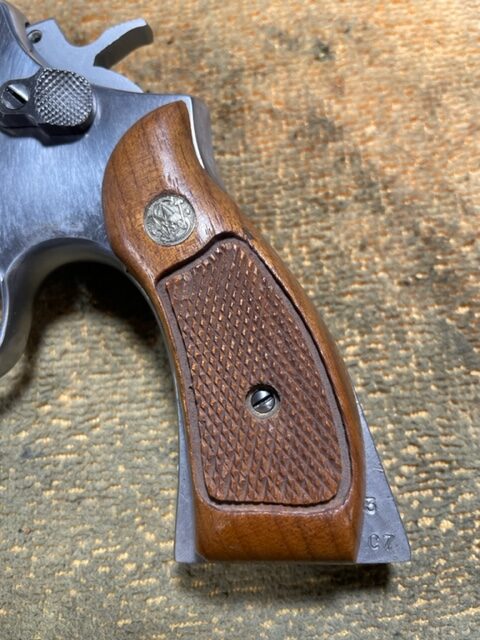
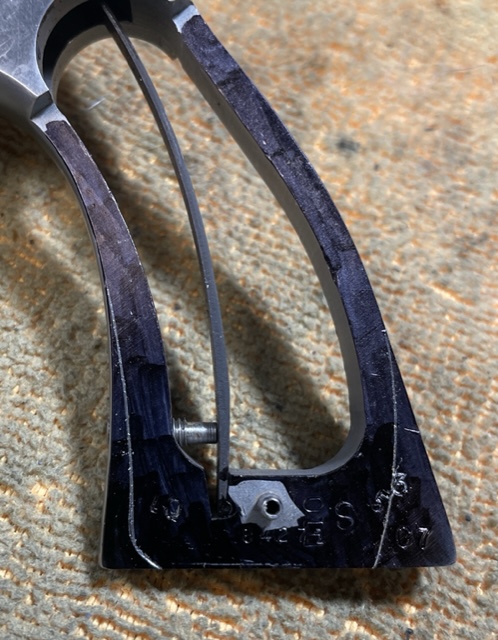
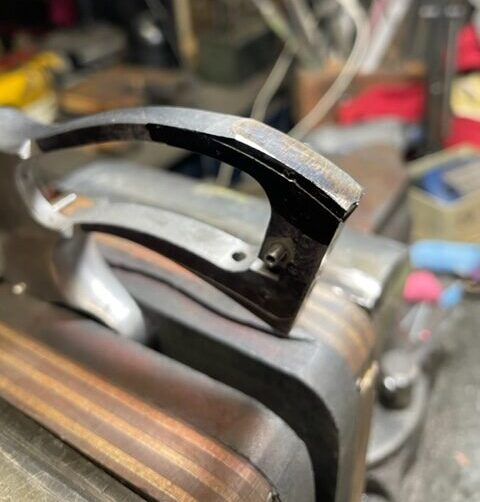
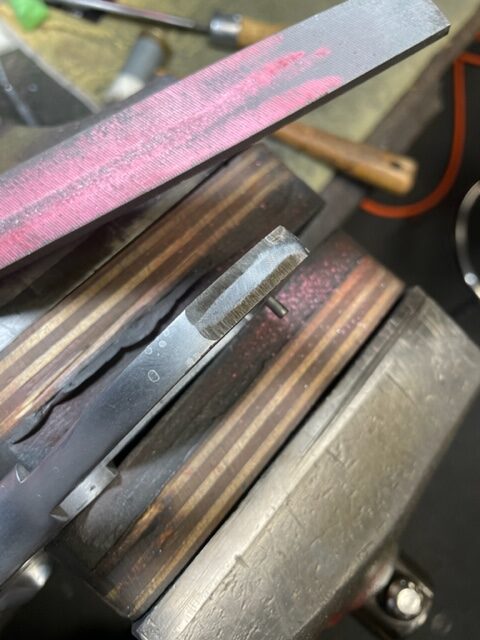
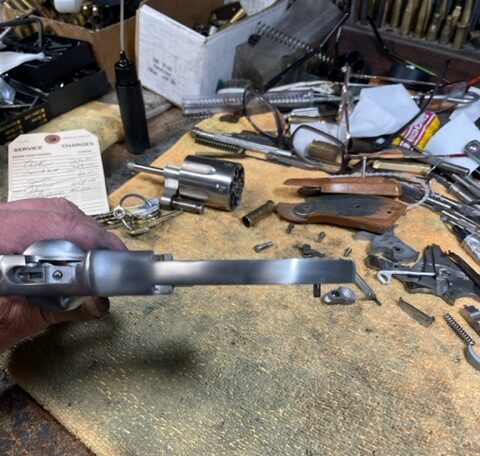
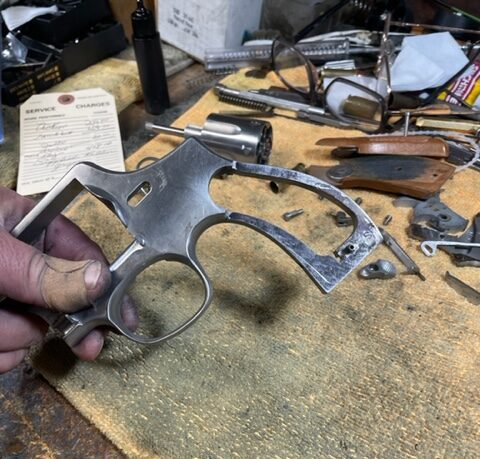
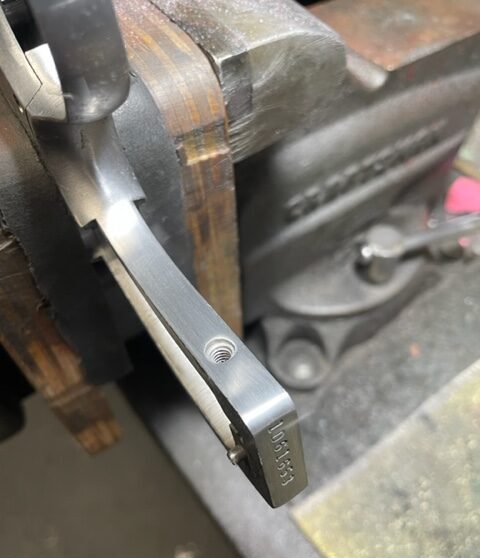
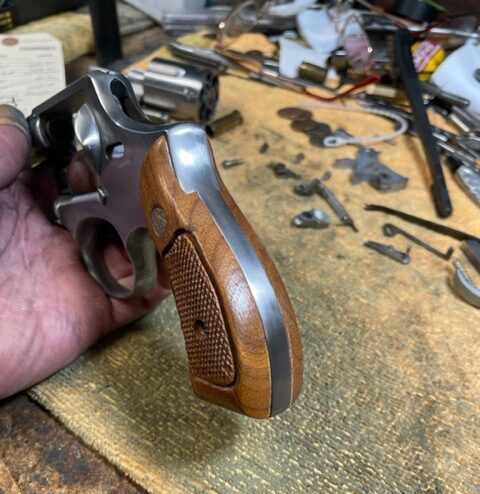
Summary
We’d like to thank Nelson for giving us a peek behind the curtains of a real gunsmithing shop, and showing us how he does his conversion magic.
We would strongly encourage RevolverGuy readers to contact Nelson (phone is best—602-992-0050) if you have a desire to round butt one of your guns. He’ll do it right, and enhance the handling qualities of your revolver without any of the “aw crud!” moments you’ll encounter if you try doing it on your own.
We’d also like to hear from you in the comments below, about your preferences. Do you favor the round butt or square butt design on your guns? Does it depend on the type of gun for you? Do you like them both, equally? Do you wish S&W still offered a SB option, or are you satisfied with putting SB conversion grips on a RB frame? Let us know what you think.
Watch your butts and be safe out there!
Sorry, I couldn’t resist that one, either.
*****
endnotes
- Supica, Jim & Nahas, Richard. Standard Catalog of Smith & Wesson, Third Edition, Gun Digest Books, 2006, pp.62-3;
- Ibid, pp.64-89;
- Ibid, pp. 137-8;
- Ibid, p. 21, 140-2;
- Sapp, Rick. Standard Catalog of Colt Firearms, Gun Digest Books, 2007, pp.91-6;
- Ibid, pp.102-110;
- Prasac, Max. Gun Digest Book of Ruger Revolvers, Gun Digest Books, 2013, p.96;
- Ibid, p.97;
- Ibid, p.101, 110;
Featured Image
Featured image from Eagle Grips, Inc.

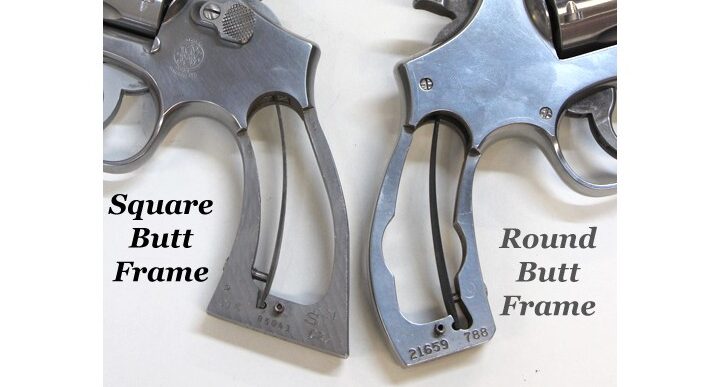
Excellent writeup. Many thanks to Nelson Ford for sharing his step by step conversion process. His technique varies slight from mine in that I use a fine grain compounding wheel to give the final finish.
Both grip configurations have their advantages and disadvantages, so it’s almost impossible to say which is best. However, when it comes to concealed carry, the round butt configuration has far too many advantages to ignore or discount. Interesting to note that Smith & Wesson, despite producing the revolvers with all round butts now, have square butt conversion grip panels for those who prefer the square configuration. The Square Butt ain’t quite dead.
In the 1970s the thought of wielding my old 5″ S&W M27 with a round butt seemed like trying to hold a cinder block with a stick. By the 1990s, the S&W 5″ M629 Magna Classic round butt was a dream to shoot (slightly downloaded of course) despite being very muzzle heavy.
My 2.5″ S&W M66-3 came from the factory as a round butt, as did my 3″ M65-5. My 4″ S&W M66 and 4″ M67 started off as square butts, but are all round butts. With a set of Hogue round butt grips, all shoot and handle extremely well. Having said that, my 4″ S&W M13 still wears its square butt, and I’m starting to get the itch to round butt it, too.
As much as I like the feel of a RB K-Frame, I’d be tempted to leave that M13 as is, unless you really intended to carry it a lot. With the SB frames having gone the way of the dodo, I kinda feel like we need to preserve some of them, for posterity. I have no problem with round-butting a working gun, but I’m content to leave my safe queens as SBs.
I agree. Back when I carried concealed revolvers for a living, I had a 4-inch Model 66 and a 4-inch Security-Six round-butted to match my shorter-barreled K-frames, and I loved them, but I kept the square butt on the 6-inch 66 I used for PPC. I found the round-butt K-frame (or Security/Speed Six) perfect for concealment and pointability, and didn’t affect the way the gun handled in recoil. My favorite guns, revolver or auto, are round-butt K-frames. (I guess that tells you how, um, seasoned I am.)
1811, I may not have as many miles on the odometer, but RB K-Frames are my favorites, too. We just appreciate good things.
Ruger did get away from dealing with multiple butt styles on most of their revolvers, but the Redhawk still features a traditional grip frame. There, the round butt is used on the 2.75″ .357 and on the 4.20″ .45 ACP version with the square butt being found on all the others at the moment. I say “at the moment” because distributor exclusive versions will some times be round butt and some times square butt. Also, Ruger previously had a 45 Colt/ACP version that had (if I recall correctly) a round but with a 4.20″ barrel and may have had some round butt .44 Magnum versions. It seems that Ruger uses round butts on the guns more likely to be used for “social” purposes (short barrels or bottom-feeder cartridges) and uses the square butt on guns more likely to be used for sporting purposes.
Good call, Greyson. I didn’t have the Redhawk on my radar.
Outstanding article Mike! I have carried both SB and RB Smiths and I have determined I prefer a SB for a duty size revolver that I intend to wear on a belt, open carry outside the waist band. For a conceal carry gun, the RB feels like it doesn’t grab my shirt as bad, especially with bantam or boot grips. The 66-8 I am evaluating with its RB is really carrying nicely and may become my every day revolver.
That seems to be the way of things, Mark. The SB seems to work very nicely in that role. Keep us updated on your experience with the new M66 please. Drop me an email with your thoughts.
Put down another vote for the round butts. My hands work better with them.
Had several occasions to shake hands with Bill Jordan. Let me restate that I shuck my hand and he shuck a no. 12 frying pan . I see now why his model 19 looked like a J frame in those mits.
Just can not make my grip comfortable with the square target grips, maybe close on the cokes. There has been a large industry in after market grips pretty much since hand ejectors can out. Of all the contenders, the LAPD school and Craig Spegel are my favorites. Just wish they were a tad bit more affordable, but what’s it worth to be able shoot better.
I shoot double action 97% of the time so it is definitely round for me.
Mike thank you for another great article that I hope you will include in your future book on the revolver. Thanks to all the good folks on here who share their hard earned knowledge.
Stay safe in our crazy times!
Tony
Oh Tony, are you trying to call me out? I’ve got so many unfinished projects already, and couldn’t think of adding another!
My dad and brother met Jordan once, and dad (who stood 6’3”) said he was “a really long drink of water.” He didn’t say that about many folks.
Those Combat Magnums sure did disappear in his hands, didn’t they?
It’s a revolver, they’re all great…. Favor the RB K frame, carries easy, quick to present, fits my hand. J frames are too small for my liking, no matter what grip is on them. The new 66-8 4″ with the RB, might be next with a SB conversion grip as an option. SB for my heavier guns and longer barrels.
Excellent article on the pros and cons of each. I have carried both but, now exclusively a RB K frame since it is used for concealed carry and I always bob the hammers so no need for SA shooting which, in my opinion, is the single advantage of a SB.
My carry gun has not changed since I found a 2″ model 10 RB. Carry perfection for me. I can conceal 6 rounds of 158 grain +P under a T shirt without printing. I could not do that with any of my short gripped semi autos. That square edge grip is just too obvious.
That sounds like a great combo, Chris!
My Model 10’s and Model 12 are both SB, but every other S&W I have is RB. I don’t notice a difference in shooting, but I do find a RB easier to conceal in my experience. SB has a bit more bulk to it.
Thanks Mike, for the good article. If you will forgive the mainstream term, this site is my happy place! Always good info and it’s great to hear from revolver folk from around the globe in the comments. I agree with Chris Lund on where the RB shines. 2″ K frame RB’s just hide better for me than almost any semi auto and do so more comfortably. J frame size RB’s when the occasion will not allow a K frame to hide.
Thanks Kevin! That’s wonderful praise coming from you, buddy. I’m so proud of our team and the great home we’ve built for all those afflicted with revolver fever!
I always though the SB was not ergonomic and prefer RB. However I had a Pythons with Fuzzy Farant SP? Grips ,had to bob the front of the frame, but they were great, another gun I let get away 😢
Ooh, that definitely would have been one to hang onto. We live, and (hopefully) we learn!
Mike
Thanks for the great research on the history of revolver butt evolution. I definitely learned a couple bits from it.
Rounding a butt isn’t a hard job if you have some patience and a little skill with hand tools. I’ve done a couple over the years that turned out well. Remember the old days when police trade in K frames could be had for less than a day’s wages?
Since I’m an amateur I don’t use a grinder when converting the butt. Just hacksaw off most of the excess. A good sharp file and liberal use of chalk to keep the file from clogging and scarring your work is an important part of a workmanlike result.
I shoot double action, so the round butt works best for me. That protrusion on the front of the square butt tends to cause me some trouble getting out of the holster. I actually modified a set of grips for my PPC gun that solved that problem. They’re pretty thin on the front strap. I should have just chopped off the offending steel and made new stocks. Might just have to do that once things get back to normal around here.
Still can’t bring myself to round butt my Model 12.
Thanks John, great to see you here! Not having done much file work myself, I was excited to hear about your trick with the chalk. That’s a neat bit of info that I’ll store away for future use. The PPC grip mod sounds good to me—I’d rather reduce the wood than the steel, if I can get away with it. Easier to fix, if things don’t go right!